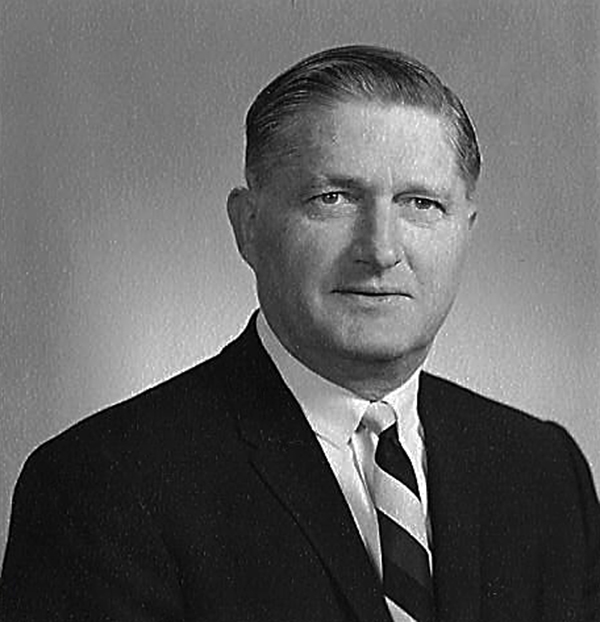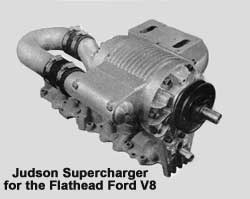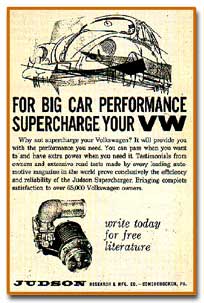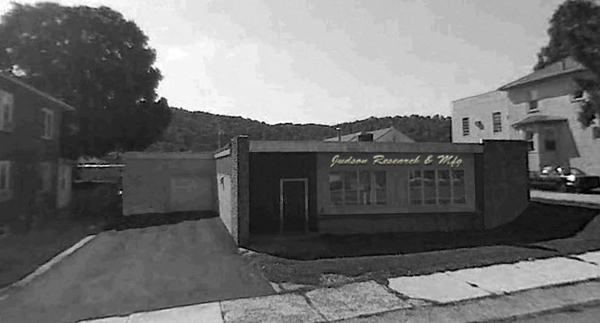|
|
The Judson Register is Closing/Relocating
2nd November 2015
|
After just over 15 years running this website on Judson Superchargers it’s time to make moves to secure the information for the foreseeable future. The main components of the website have been carefully dismantled into its useful component parts and re-housed for future generations of “Vintage Speed” enthusiasts. Where can you find these “useful component parts”? After a discussion with Everett Barnes of The Samba.com he has kindly found a cosy corner of The Samba Archive to house Judson History...Installation Instructions...Promotional Material... Magazine Test Reports and Technical Articles….the meat of this Judson Register website. You’ll find it all here: http://www.thesamba.com/vw/archives/lit/ If you have questions about your VW installation or fine tuning your Judson kit then The Samba.com also has an excellent “Vintage Speed” forum where you can pose your questions or search the forum to find many questions have already been answered: http://www.thesamba.com/vw/forum/viewforum.php?f=44 Just one last BIG vote of thanks to all the Judson enthusiast out there who helped make this website “the place to go to” for information relating to Judson Superchargers. I’d particularly like to thank the late W. Haddon Judson jnr. (Haddie) R.I.P, Rocco Antonelli, Alejandro Martin and George Folchi…without their assistance and knowledge, the understanding of Judson Superchargers and the people behind it, would be incomplete. If you need Judson parts, a restoration or a full kit you’ll find George Folchi, (gbfolchi@yahoo.com) Alejandro Martin (almar9@hotmail.com) and Richardo Deisernia (http://www.splitpartsunlimited.com/index.php) are still able to meet your needs. Thank you again...it's been fun. John E Moxon
|
|
Judson Research & Mfg. Co. History
|
|
Since 1880 the Judson Family have been involved in some form of mechanical and electrical engineering. It's a story of enterprise and innovation, from farming machinery through to electronics for the defence and automotive industries. Of course stationed along the route was the Judson Supercharger, a product that was a natural spin-off from a small interest in producing custom-made racing superchargers. |
|
|
|
The
supercharger manufacturing unit was part of Judson Bros. of
Collegeville PA,- who made farming machinery- this
company was absorbed into what was to become the parent company, Judson
Research & Mfg. Co. of Conshohocken PA. in the early 1950s. Production
superchargers were developed shortly after this amalgamation, starting with a
sliding vane supercharger for the Flathead Ford V8, followed W. Haddon
Judson (1914-1988) was the prime mover in the development of the company and
in the technical innovation of the supercharger aided by his brother Charles A Judson. New
models were added steadily over the next five years until the full range
included superchargers for MG TD, TF and MGA, Renault Dauphine, Triumph TR3
and 4, Mercedes 190SL, Volvo, Austin-Healey Sprite, the Corvair
and of course two versions for Volkswagens. The two VW types were a natural
progression. The first was for the 30/36hp engine and the second for the
34/40hp unit introduced in August 1960. For the Karmann Ghia the kit included
an aluminium air scoop for the deck lid but in all other respects the two
Judsons fitted across the range until the advent of the 1500cc engine in
1967. From the outset it didn't take long for Volkswagen owners to look for ways to breathe new life into their underpowered Beetles. As a consequence business for the Judson Research & Mfg. Co. and in particular sales for their VW Judson Supercharger flourished. Despite the sliding vane supercharger's origins as a bespoke unit for motor sport, the Judson company wisely targeted the average motorist in its advertising campaigns. It's easy to understand, the mass market was the average guy. Certainly with the Volkswagen, which was an economy model, it was important not to price the supercharger kit out of their reach. |
|
Advertising. |
|
The
advertising firm that handled the Judson account was the "Williams
and Avery Advertising Co." in fact this was simply William
Haddon Judson and Charles Avery Judson...they kept everything "in
house." Early
advertising was strictly factual without fancy flourishes; pictures were
straight engine shots and text just emphasised the power gains that could be
got by fitting a Judson Supercharger. The adverts offered "Free
literature and data" by writing to the company in Conshohocken. From
1953 onwards "Road & Track" magazine was one of the main
advertising outlets with a more noticeable presence when the magazine
conducted a road test on the latest Judson model. Reviews of the Judson
models started in November 1953 when the Judson for the Flathead Ford was
reviewed in the magazine "Speed Age"
followed a year later with the "Road & Track"
review for the Judson MG-TF model. With the
introduction of the VW model in early 1956 the promotional material for
Judson Superchargers became more model specific, with the VW Judson getting a
brochure and a promotional postcard sent out to those responding to magazine
adverts. The VW Karmann Ghia, Volkswagen's new "sporting A new
addition to the newsstands at this time, afforded the Judson Company with
another avenue of exposure; the magazine "Foreign Car Guide" . In the
first issue of Fall 1956 the magazine ran an article outlining supercharger
options for the VW. The article, although mentioning most of the Judson's
small supercharger rivals, featured the Judson heavily in its text and with a
page of pictures giving pictorial instructions of the Judson installation. A
review of the VW model appeared in the September 1957 issue of "Road & Track";
the positive review also giving sales a useful boost. From the
VW model's early exposure in issue number one of "Foreign Car
Guide," the Judson Company took the back page of every issue of the
magazine until December 1966. It's in the company's back page advertising for
"Foreign Car Guide" that you'll notice a more "look at
me style" with a stylised graphic of a speeding Beetle, a space-age
rocket advertising 50% more power and how to turn your Beetle into a
"Super Beetle." In the "Foreign
Car Guide" the company had found the ideal billboard for its best selling supercharger as,
with the popularity of the VW Beetle, the magazine's content began to be
dominated by the German import. |
|
Sales |
|
Right
from the start of the VW model the company claimed in it's
advertising, "thousands of happy owners". Well yes, eventually they
did sell thousands of the VW model but those early claims, in the 1956
brochures were something of an exaggeration. At this
stage the company were offering their kits, direct from the factory, through
specialist agents and official VW dealerships. As an example, Judson's West
Coast stockist Bill Correy was also a
representative for Pepco Superchargers and a regular feature contributor to "Road
& Track" magazine. I would expect he had no small part in
getting the Judson reviewed in the September '57 issue. The VW Kit at this
time retailed for $149.50. The fact
that Judson were selling their supercharger kits for the VW through VW of
America's official dealership network is a little surprising, given VWs
open hostility to any tinkering with their flat 4 engine.
It is also surprising that it wasn't until 1960, that VWoA
decided to put their foot down; threatening any official VW dealership with
the loss of their franchise if they continued selling accessories not
sanctioned as official VW accessories. VWoA
also reminded dealerships, that fitting a Judson Supercharger to a VW would
immediately invalidate their warranty. The
closing of these sales outlets led to the production of a Judson
"Personal Memo" mail-shot to prospective owners who had already
asked for product details. In it Charles Judson explains why local VW dealers
were no longer stocking the Judson Supercharger. More importantly to the
buyer, the memo announced the company was passing on the dealer discount,
reducing the price of the VW kit from $144.00 to a very attractive, $100.00
when buying a supercharger direct from Judson's Conshohocken workshop.
|
|
1964-1976 |
|
We are fortunate to have, in the writing of this
"history" the assistance of Rocco Antonelli to paint a picture of
the Judson Research & Mfg Co. during these last
12 years of supercharger production. Rocco joined the company in 1964 as an 18
year old after what Rocco recalls as rather an intimidating interview.
Both Haddon and Charles Judson conducted the "grilling," putting
Rocco through his paces to see if he would stand his ground. "Can
you hold a thousandth," probed Haddon brusquely. "If
your machines are up to it, I can hold a tenth of that," was Rocco's reply. Haddon
turned to Charles and said, "Let's see if he's as good as he says he
is." "Boy...you
start on Monday." Rocco was
to be part of a close-knit team in a precision engineering environment...if
you couldn't "cut it" you would be out. William Haddon Judson was a
"hands on" owner who ran a tight ship. Rocco slotted right into the
operation, which saw him gain the trust of the demanding owner to such an
extent that he found himself in charge of the Supercharger Division inside of
two years! It was a relationship of mutual respect. The two
Judson brothers were the driving force of the Judson Research & Mfg.
Co. but almost direct opposites in character: William Haddon Judson was the innovator and inventor, the very reason the company was a success. He had a tough exterior, didn't suffer fools gladly and would let you know exactly what he thought. Not for him the confines of the office, "Had" set his personal lathe at the head of the machine-shop and got his hands dirty along with the rest of his team. You would rarely see Haddon out of his white lab-coat. Haddon drove a silver Mercedes 190 with beautiful red leather upholstery, it was his pride and joy...supercharged of course. Although Haddon never took the academic route to engineering proficiency he was made an honorary member of the "Society of Automobile Engineers" (SAE). He was proud to display the citation on a plaque in the hallway that linked the offices to the workshop. Charles Avery Judson was the administrator and PR man. Charles spent his day in the office, dealt with finances, advertising and customer relations. Charles was a very elegant man, always dressed immaculately in tailored suits and bow-tie. Although it was Haddon who was the engineer, it was Charles who drove the fast cars...most of them supercharged too.
|
|
Staffing. |
|
One might
consider a company that produced a variety of original engineering and
electronic products from its facility in Conshohocken to be quite a large
concern, with a staff of between 30 and 50 people...not so. The Judson
Research & Mfg. Co was at no stage manned by more than 10 members of
staff. Having said that, many of that number would have the capability to
"multi-task" across engineering and electronic projects and, as the
company name suggests, research into new products. We'll let Rocco recount the main Judson staffing during the
time he was recruited... W. Haddon Judson had three children; two sons, W. Haddon Judson jnr and Gregory Judson and a daughter, Patricia. Although the two sons worked with their father, Haddon jnr. spent a large part of the 1960s in the US Navy and sadly Greg died suddenly in his early 20s. The the early death of Greg was a tragic blow to the family and understandably hit his father badly for quite some time afterwards. Charles A Judson had one son, Christopher. The two
Judson brothers insisted on a tight discipline in the workplace...no talking,
except at break time..."and put the cigarette down, I'm paying you
for two hands, not one!" However it didn't
stop Haddon from flipping me with the occasional cigar as he returned from
his lunch break. I kept it to smoke in my own time of course. Neven Tyson was a supervisor who ran a turret lathe which was centrally located so he could see the whole shop. "Nev" was a war hero and I can't say enough of how nice a man he was. He was one of the few survivors of the WWII Bouganville campaign, in the South Pacific. His recollections of that campaign were the stuff of nightmares; it forever gave him a deep respect for life, and his fellow workers. I learned valuable life lessons, as well as gained a friend in Nev. Stanley Pruskowski, shop foreman, who loved to work overtime and did a dance he called "The Overtime Samba" whenever Saturday working was posted. Rich Baker, who ran the electronics department and the owner of a "nasty" white Corvair. Rich and I worked that car over until it screamed! And of course myself, Rocco Antonelli. That pretty much rounds up the people who
worked there for any period of time. There were
others who came and went in the meantime but just a core workforce of six
people made up Judson Research & Mfg. Co. for a large part of my
time at the Conshohocken PA. facility. Editorial note: Rocco was considered by Haddon Judson to be the
best lathe worker he had ever worked with and when the company closed the
supercharger operation in 1976, gave Rocco glowing job references, and
introductions which helped further his later career.
|
|
The Judson Workshops. |
|
At the time of writing no period pictures of the Judson
facility at Hector Street, Conshohocken has been found but as the workshops
still stand, I have adapted a recent "Google Earth" picture
with Rocco's assistance, to show the workshop and offices as it would have
appeared in the mid 1960s. In the mid 1950s the supercharger operation was relocated to 541 E. Hector Street, Conshohocken (pictured right) and it was from here most of the Judson Superchargers were made and despatched. Later, the modern day Judson Company was restarted by W. Haddon Judson Snr. and W. Haddon Judson Jnr. in an old tubing mill on Washington Ave. in Conshohocken. The same tubing mill that was started by W. Haddon Judson Snr's father, originally making .30 and .50 calibre machine gun barrels for the military during World War Two. |
|
So what was it like inside the E. Hector Street facility? Rocco
has kindly drawn a pen-picture of the set-up and lay-out of the workshop. |
|
Rocco
continues: The
Judson building from the front was a single story, twelve-car garage, an
imitation stone fascia with a large picture window, a 2 cars deep single lane
driveway nestled between two old private homes. From the back, a large garage
with one shipping dock, one receiving dock and one employee entrance door.
Although a nice looking place and spotless on the
inside, you would never believe any type of machining ever took place in this
shop. It looked more like a show place for old machinery. Now to
the shop lay-out, I only hope I can describe the shop well enough that you
can visualize it. It was, as machine shops go, Outstanding! "Had"
insisted on sparkling clean machinery. We had to brush and wipe down, then
blow down every machine used, then run fresh lithium grease through the
bearings, until the grease was clean. Repeat in the morning if machine was to
be used. In 10 years or so, we had to replace one bearing in one drill press! The
back of the building had 3 doors, two over head,
one small centre door for employees entry. Castings
were made at the Emmaus Foundry Co, in Emmaus, Pa. (this company was also
owned by W. Haddon Judson). Castings were delivered by truck and stacked on
the concrete floor to help season them (a debatable issue). As you
walked in the employee entrance, on the right side of the shop, in an
assembly line order: STEP
2 STEP
3 STEP
4 STEP
5
STEP
6 STEP
7 In
about 30 to 40 minutes, a finished housing. On the right
hand side of the shop were two milling and slotting machines to slot
the rotors, shaft and vane slots. On the left side, two beautifully
made milling machines for cutting aluminum
manifolds, both vintage; one German made, one Italian made. I would have
liked to have them, I mean they were beautiful. Next
in line a row of single head drills and multi-head tapping machines. Next
"Nev's" turret lathe, then two engine
lathes, then "Had's" magnificent British
made white enamel collet chuck. I wish that was mine also, then the band saw.
Next to that, the Infra-red laboratory. Now
the far left aisle of the shop. First the table disk
sander, a large paint booth, a degreasing tank, a Sunnen10 honing machine,
another degreaser tank. Next, the welding station and finally Had's work bench. Nev did most of the rotor work, as well as the end plates, I
did the rest including balancing on the Gishault.
Rotors were tuned and faced off by Nev as well as
slotting and threading. Most of this was done on Nevs
turret lathe, slotting was done on a modified milling /grinding indexing
table; we shared this job. As sales dropped off later in the early '70s, Nev and I took over the entire procedure. Vanes were hand
cut with a hand fed router. A radius and a slotting head (
made by Haddon ) were all that was needed. Close and careful
inspection was was the
rule. Haddon
designed, built and organized the steps and the machinery. Everything worked
just right ! |




